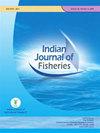对印度一个受保护水库中新鲎渔业的生物观察
IF 0.3
4区 农林科学
Q4 FISHERIES
引用次数: 0
摘要
本研究使用 300 个标本评估了 Peechi 水库(受保护的水库)中一个重要土著渔场的摄食和繁殖生物学。在线粒体 CO1 基因的帮助下,该物种被鉴定为 Salmostomanovacula。利用优势指数(IOP)、胃肠指数(GaSI)和相对肠长(RGL)对鱼类的摄食生物学进行了研究。新月鲷的优势指数(IOP)显示,浮游动物在该鱼种的肠道中占主导地位,达到近 70.82%。据估计,S. novacula 的平均 RGL 和 GaSI 分别为 1.42(1.42±0.25)和 4.22。用于繁殖研究的指标有初熟个体大小、性别比、雌雄指数和繁殖力。初熟个体大小为 13.0 厘米。性比和相对繁殖力估计为每克鱼体重 1.2:1.0 和 8500-8833 个。研究表明,鱼类在 3 月至 8 月期间成熟,9 月开始产卵活动。本文强调了在该水库实施最小合法尺寸和限制季风捕鱼以维持渔业的必要性。关键词:CO1 基因 摄食生物学 渔业管理 繁殖生物学 Salmostoma novacula本文章由计算机程序翻译,如有差异,请以英文原文为准。
Biological observations of Salmostoma novacula fishery of a protected reservoir in India
Feeding and breeding biology of a prominent indigenous fishery of Peechi Reservoir(protected reservoir) was assessed using 300 specimens in this study. Catch compositionstudies identified Salmostoma sp. as the major species contributing to the reservoir fishery.With the help of mitochondrial CO1 gene, the species was identified as Salmostomanovacula. The feeding biology of the fishes was studied using index of preponderance(IOP), gastro-somatic index (GaSI) and relative gut length (RGL). IOP of S. novacula revealedthat zooplankton dominated the gut of the species to the tune of nearly 70.82%. The meanRGL and GaSI of S. novacula was estimated at 1.42 (1.42±0.25) and 4.22 respectively. Theindices used for reproductive study were size at first maturity, sex ratio, gonado-somaticindices and fecundity. The size at first maturity for S. novacula was found to be 13.0 cm. Thesex ratio and relative fecundity were estimated at 1.2:1.0 and 8500-8833 nos. per gram bodyweight of fish. The study indicated that the fishes mature during March to August and exhibitspawning activity in September. The paper emphasises a need for enforcing minimum legalsize and restricted monsoon fishing for sustained fisheries in this reservoir. Keywords:CO1 gene, Feeding biology, Fisheries management,Reproductive biology, Salmostoma novacula
求助全文
通过发布文献求助,成功后即可免费获取论文全文。
去求助
来源期刊

Indian Journal of Fisheries
FISHERIES-
CiteScore
0.90
自引率
20.00%
发文量
0
审稿时长
6-12 weeks
期刊介绍:
Indian Journal of Fisheries is published quarterly by the Indian Council of Agricultural Research (ICAR), New Delhi. Original contributions in the field of Fish and fisheries science are considered for publication in the Journal. The material submitted must be unpublished and not under consideration for publication elsewhere.
Papers based on research which kills or damages any species, regarded as thratened/ endangered by IUCN crieteria or is as such listed in the Red Data Book appropriate to the geographic area concerned, will not be accepted by the Journal, unless the work has clear conservation objectives.
 求助内容:
求助内容: 应助结果提醒方式:
应助结果提醒方式:


